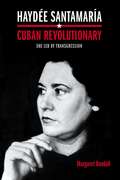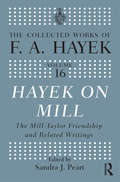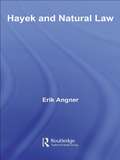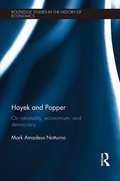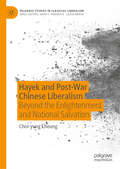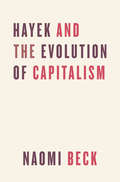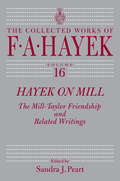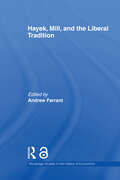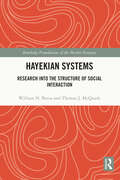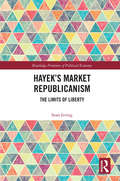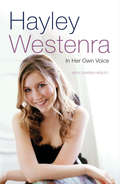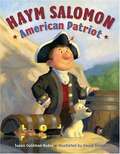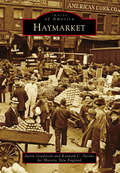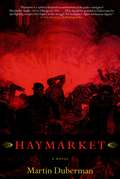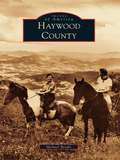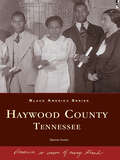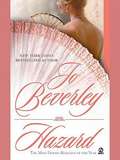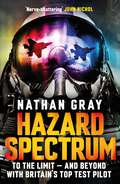- Table View
- List View
Haydn Studies 2 (Cambridge Composer Studies)
by Nancy NovemberHaydn scholarship has mirrored recent trends in musicological research with an increased interest in the cultural context and reception of his music, though he has not received the sustained consideration given to other canonical figures. Over the past decade, more consideration has been paid to Haydn's operas and oratorios which previously tended to be eclipsed by his chamber and orchestral music. These new perspectives are the focus of this collection which showcases recent approaches and allows us to re-evaluate the long-held notion that Haydn's era marked the rise of the concept of autonomous musical works. This book enriches understanding of cultural contexts in which Haydn's music is being understood, providing models for future contextual studies and allows for a more historically responsive understanding of his works. It includes analysis of less well-known compositions, especially the oratorio Il Ritorno di Tobia, Orfeo and the late canons, but also of works like the London Symphonies and The Creation.
Haydn: Joseph Haydn And Britain (The\late Eighteenth-century Composers Ser.)
by DavidWyn JonesThis volume brings together a selection of the most stimulating and influential writing on Haydn and his music in the English language. Written by a range of established and younger scholars it probes a variety of aesthetic, biographical, compositional, performance and reception issues. A specially written introduction summarizes the significance of each essay, directs the reader to appropriate complementary material and seeks the common ground between the essays; to assist with consistent referencing the individual essays retain their original pagination. This representative compendium of Haydn research provides the opportunity to explore the intellectual diversity of recent scholarship and is an indispensable publication for students of Haydn, whether new or old, amateur or professional.
Haydn’s Sunrise, Beethoven’s Shadow: Audiovisual Culture and the Emergence of Musical Romanticism
by Deirdre LoughridgeThe years between roughly 1760 and 1810, a period stretching from the rise of Joseph Haydn’s career to the height of Ludwig van Beethoven’s, are often viewed as a golden age for musical culture, when audiences started to revel in the sounds of the concert hall. But the latter half of the eighteenth century also saw proliferating optical technologies—including magnifying instruments, magic lanterns, peepshows, and shadow-plays—that offered new performance tools, fostered musical innovation, and shaped the very idea of “pure” music. Haydn’s Sunrise, Beethoven’s Shadow is a fascinating exploration of the early romantic blending of sight and sound as encountered in popular science, street entertainments, opera, and music criticism. Deirdre Loughridge reveals that allusions in musical writings to optical technologies reflect their spread from fairgrounds and laboratories into public consciousness and a range of discourses, including that of music. She demonstrates how concrete points of intersection—composers’ treatments of telescopes and peepshows in opera, for instance, or a shadow-play performance of a ballad—could then fuel new modes of listening that aimed to extend the senses. An illuminating look at romantic musical practices and aesthetics, this book yields surprising relations between the past and present and offers insight into our own contemporary audiovisual culture.
Haydée Santamaría
by Betsy MacleanHaydée first achieved notoriety by being one of the two women who participated in the armed attack that sparked the Cuban Revolution. Later, as director of the world renowned literary institution, Casa de las Americas, she embraced culture as a tool for social change and provided refuge for exiled Latin American artists and intellectuals. Included are reflections by Alicia Alonso, Mario Benedetti, Ariel Dorfman, Melba Hernandez, Roberto Fernandez Retamar and Silvio Rodriguez.
Haydée Santamaría, Cuban Revolutionary: She Led by Transgression
by Margaret RandallTaking part in the Cuban Revolution's first armed action in 1953, enduring the torture and killings of her brother and fiancé, assuming a leadership role in the underground movement, and smuggling weapons into Cuba, Haydée Santamaría was the only woman to participate in every phase of the Revolution. Virtually unknown outside of Cuba, Santamaría was a trusted member of Fidel Castro's inner circle and friend of Che Guevara. Following the Revolution's victory Santamaría founded and ran the cultural and arts institution Casa de las Americas, which attracted cutting-edge artists, exposed Cubans to some of the world's greatest creative minds, and protected queer, black, and feminist artists from state repression. Santamaría's suicide in 1980 caused confusion and discomfort throughout Cuba; despite her commitment to the Revolution, communist orthodoxy's disapproval of suicide prevented the Cuban leadership from mourning and celebrating her in the Plaza of the Revolution. In this impressionistic portrait of her friend Haydée Santamaría, Margaret Randall shows how one woman can help change the course of history.
Hayek On Mill: The Mill-Taylor Friendship and Related Writings (The Collected Works of F.A. Hayek #16)
by Sandra J. PeartBest known for reviving the tradition of classical liberalism, F. A. Hayek was also a prominent scholar of the philosopher John Stuart Mill. One of his greatest undertakings was a collection of Mill’s extensive correspondence with his longstanding friend and later companion and wife, Harriet Taylor-Mill. Hayek first published the Mill-Taylor correspondence in 1951, and his edition soon became required reading for any study of the nineteenth-century foundations of liberalism. This latest addition to the Collected Works of F. A. Hayek series showcases the fascinating intersections between two of the most prominent thinkers from two successive centuries. Hayek situates Mill within the complex social and intellectual milieu of nineteenth-century Europe—as well as within twentieth-century debates on socialism and planning—and uncovers the influence of Taylor-Mill on Mill’s political economy. The volume features the Mill-Taylor correspondence and brings together for the first time Hayek’s related writings, which were widely credited with beginning a new era of Mill scholarship.
Hayek and Natural Law (Routledge Frontiers Of Political Economy Ser.)
by Erik AngnerProviding a radical new reading of Hayek's life and work, this new book, by an important Hayekian scholar, dispels many of the mysteries surrounding one of the most prominent economists and political philosophers of the twentieth century.Angner argues that Hayek's work should be seen as continuous with the Natural Law tradition, going on to an
Hayek and Popper: On Rationality, Economism, and Democracy (Routledge Studies in the History of Economics)
by Mark NotturnoKarl Popper and Friedrich von Hayek are remembered as two of the twentieth century’s greatest proponents of open society. However, over the years, Hayek’s ideas have tended to be favoured over Popper’s in both academic and political discussions. This book aims to improve understanding of Popper’s and Hayek’s philosophies by explaining their differences, and whilst doing so, to encourage liberal political philosophers to take a better-informed and more sympathetic look at Popper’s ideas about open society. Popper and Hayek differed in subtle but fundamental ways about rationality, economism, and democracy. They thus differed about whether and to what extent society is well served by deliberate attempts at social engineering and government intervention in the economy. They also differed about whether democracy is better served by institutions designed to elect the best leaders, or by institutions designed to protect us against the leaders we elect. And they differed, perhaps most importantly, about whether we should value freedom as a means to prosperity or an end-in-itself. This book argues that Hayek’s views about rationality, economism, and democracy are fundamentally at odds with Popper’s¾ and perhaps even with open society itself—and that the unintended consequences of Hayek’s views may actually pose a threat to Popper’s vision of a liberal and free open society.
Hayek and Post-War Chinese Liberalism: Beyond the Enlightenment and National Salvation (Palgrave Studies in Classical Liberalism)
by Chor-yung CheungThis book is a study of comparative social and political theory, examining how Hayek’s classical liberalism has been influencing the development of Chinese liberalism since 1949. While both Chinese liberalism and the thought of Hayek can each be studied in its own right, this is the first systematic study on how Hayek’s ideas have helped post-war Chinese liberals enrich their social and political theory in the pursuit of freedom and in formulating theoretical responses to the challenges of modernity in China. This book examines and identifies those central theoretical tenets of Hayek that are most inspiring to the post-war Chinese liberals in their efforts in developing a more robust and profound understanding of freedom in the Chinese context. It argues that the new post-war understanding of Chinese liberalism has superseded the social democratic understanding that was widely adopted by pre-war Chinese liberals. These theoretical/Hayekian tenets include: the critique of totalitarianism and scientism, the idea of the free market, the insights inherited from the Scottish Enlightenment to counter the excess of Cartesian Rationalism, the thesis of the concurrent evolution of culture and mind, and the central importance of the rule of law in defending individual freedom. This book aims to help political theorists and historians of comparative political thought both in the East and in the West better understand the intellectual issues involved and explore further research endeavours in the same area.
Hayek and the Evolution of Capitalism
by Naomi BeckFew economists can claim the influence—or fame—of F. A. Hayek. Winner of the Nobel Prize, Hayek was one of the most consequential thinkers of the twentieth century, his views on the free market echoed by such major figures as Ronald Reagan and Margaret Thatcher. Yet even among those who study his work in depth, few have looked closely at his use of ideas from evolutionary science to advance his vision of markets and society. With this book Naomi Beck offers the first full-length engagement with Hayek’s thought from this perspective. Hayek argued that the capitalism we see in advanced civilizations is an unintended consequence of group selection—groups that adopted free market behavior expanded more successfully than others. But this attempt at a scientific grounding for Hayek’s principles, Beck shows, fails to hold water, plagued by incoherencies, misinterpretations of the underlying science, and lack of evidence. As crises around the globe lead to reconsiderations of the place of capitalism, Beck’s excavation of this little-known strand of Hayek’s thought—and its failure—is timely and instructive.
Hayek on Mill: The Mill-Taylor Friendship and Related Writings (The Collected Works of F. A. Hayek #16)
by Friedrich A. Hayek Sandra J. Peart edited by Sandra J. PeartBest known for reviving the tradition of classical liberalism, F. A. Hayek was also a prominent scholar of the philosopher John Stuart Mill. One of his greatest undertakings was a collection of Mill's extensive correspondence with his longstanding friend and later companion and wife, Harriet Taylor-Mill. Hayek first published the Mill-Taylor correspondence in 1951, and his edition soon became required reading for any study of the nineteenth-century foundations of liberalism. This latest addition to the University of Chicago Press's Collected Works of F. A. Hayek series showcases the fascinating intersections between two of the most prominent thinkers from two successive centuries. Hayek situates Mill within the complex social and intellectual milieu of nineteenth-century Europe-as well as within twentieth-century debates on socialism and planning-and uncovers the influence of Taylor-Mill on Mill's political economy. The volume features the Mill-Taylor correspondence and brings together for the first time Hayek's related writings, which were widely credited with beginning a new era of Mill scholarship.
Hayek's Bastards: Race, Gold, IQ, and the Capitalism of the Far Right
by Quinn SlobodianHow neoliberals turned to nature to defend inequality after the end of the Cold WarNeoliberals should have seen the end of the Cold War as a total victory—but they didn&’t. Instead, they saw the chameleon of communism changing colors from red to green. The poison of civil rights, feminism, and environmentalism ran through the veins of the body politic and they needed an antidote.To defy demands for equality, many neoliberals turned to nature. Race, intelligence, territory, and precious metal would be bulwarks against progressive politics. Reading and misreading the writings of their sages, Friedrich Hayek and Ludwig von Mises, they articulated a philosophy of three hards—hardwired human nature, hard borders, and hard money—and forged the alliances with racial psychologists, neoconfederates, ethnonationalists, and goldbugs that would become known as the alt-right.Following Hayek&’s bastards from Murray Rothbard to Charles Murray to Javier Milei, we find that key strains of the Far Right emerged within the neoliberal intellectual movement not against it. What has been reported as an ideological backlash against neoliberal globalization in recent years is often more of a frontlash. This history of ideas shows us that the reported clash of opposites is more like a family feud.
Hayek, Mill and the Liberal Tradition (Routledge Studies In The History Of Economics Ser. #121)
by Andrew FarrantA PDF version of this book is available for free in open access via www.tandfebooks.com as well as the OAPEN Library platform, www.oapen.org. It has been made available under a Creative Commons Attribution-Non Commercial-No Derivatives 3.0 license and is part of the OAPEN-UK research project. This book considers the relationship between Hayek and Mill, taking issues with Hayek’s criticism of Mill and providing a broader perspective of the liberal tradition. Featuring contributions from the likes of Ross Emmett, Leon Montes and Robert Garnett, these chapters ask whether Hayek had an accurate reading of the ideas of Mill and Smith, as well as considering themes such as sympathy and analytical egalitarianism that play a large part in the liberal tradition, but less in work of Hayek These chapters argue that addition of these key ideas to the Hayekian corpus leads to a far broader understanding of the liberal tradition than that provided by Hayek
Hayek: Part XIII: 'Fascism' and Liberalism in the (Austrian) Classical Tradition (Archival Insights into the Evolution of Economics)
by Robert LeesonHayek claimed that he always made it his rule ‘not to be concerned with current politics, but to try to operate on public opinion.’ However, evidence suggests that he was a party political operative with ‘free’ market scholarship being the vehicle through which he sought – and achieved – party political influence. The ‘main purpose’ of his Mont Pelerin Society had ‘been wholly achieved’. Mises promoted ‘Fascists’ including Ludendorff and Hitler, and Hayekians promoted the Operation Condor military dictatorships and continue to maintain a ‘united front’ with ‘neo-Nazis.’ Hayek, who supported Pinochet’s torture-based regime and played a promotional role in ‘Dirty War’ Argentina, is presented as a saintly figure. These chapters place ‘free’ market promotion in the context of the post-1965 neo-Fascist ‘Strategy of Tension’, and examine Hayek’s role in the promotion of deflation that facilitated Hitler’s rise to power; his proposal to relocate Gibraltarians across the frontier into ‘Fascist’ Spain; the Austrian revival of the 1970s; the role of (what was presented as) ‘neutral academic data’ on behalf of the ‘International Right’ and their efforts to promote Franz Josef Strauss and Ronald Reagan and defend apartheid and the Shah of Iran
Hayekian Systems: Research into the Structure of Social Interaction (Routledge Foundations of the Market Economy)
by William N. Butos Thomas J. McQuadeThe central theme in the work of F.A. Hayek was the problem of order in society, and his focus was epistemological: he was concerned with the constraints on knowledge, the problems associated with its distribution, the structures in which it inheres, and the implications of these issues for the understanding of social phenomena generally. But while his work has greatly improved our understanding of market processes, application to more complex social arrangements was not an unambiguous success. In seeking to progress beyond Hayek’s difficulties in formulating a more general theory of spontaneous order, this book fleshes out an analogy between social orders and the biological order detailed in Hayek’s The Sensory Order into a theory of adaptive systems. It focuses first on those aspects of the systems which enable them to learn about their environments, and then on the entrepreneurial processes which implement their anticipatory capabilities. The inclusion of anticipatory elements, inspired by the work of Robert Rosen, results in a theory of social orders which integrates many of the disparate findings of Austrian economists into a self-consistent conceptual framework and has applicability to other social arrangements such as firms and governments. Of particular interest is the interaction between the systems of science and government, an issue of significant current concern which is comprehensively explored here both theoretically and empirically. This book is essential reading for anyone interested in Hayek, Austrian economics, social theory, and the history of economic thought more broadly.
Hayek’s Market Republicanism: The Limits of Liberty (Routledge Frontiers of Political Economy)
by Sean IrvingFriedrich Hayek was the 20th century’s most significant free market theorist. Over the course of his long career he developed an analysis of the danger that state power can pose to individual liberty. In rejecting much of the liberal tradition’s concern for social justice and democratic participation, Hayek would help clear away many intellectual obstacles to the emergence of neoliberalism in the last quarter of the 20th century. At the core of this book is a new interpretation of Hayek, one that regards him as an exponent of a neo-Roman conception of liberty and interprets his work as a form of ‘market republicanism’. It examines the contemporary context in which Hayek wrote, and places his writing in the long republican intellectual tradition. Hayek’s Market Republicanism will be of interest to advanced students and researchers across the history of economic thought, the history of political thought, political economy and political philosophy.
Hayley Westenra: In Her Own Voice
by Hayley Westenra Darren HenleyHayley's first performance as 'Little Star' in a Christmas play was perfectly pitched, beautifully sung and enthusiastically received. She was six years old. Now, at the tender age of twenty, she is the fastest-selling debut classical artist ever. Her string of musical accolades is astonishing and her audiences range from royalty to premiers.This is her story, from her first performance, through later roles in major productions such as Annie, La Bohème and The Sound of Music, her decision at the age of eleven to busk for her lunch money, and the subsequent record deals, money, charity work and classical superstardom.
Haym Salomon: American Patriot
by Susan Goldman Rubin David Slonim<p>"The story of one of Americas first true patriots" <p>Everyone knows Revolutionary War figures George Washington, Benjamin Franklin, and Paul Revere, but Haym Salomon was also an important hero, and his accomplishments are finally gaining recognition in this biography that will entertain as it introduces its unique subject. Haym was one of the few Jewish patriots of the time. His knowledge of languages and currencies made him an exceptional man in pre-Revolution New York. <p>Incredibly valuable to the revolutionary cause, Haym risked his life and his fortune, went to prison, and was forced to abandon his home and family all for the sake of American independence. <p>Acclaimed author Susan Goldman Rubin, along with illustrator David Slonim, brings Hayms remarkable story to life.</p>
Haymarket
by Kenneth C. Turino Historic New England Justin GoodsteinWith Faneuil Hall opening in 1742, followed by Quincy Market in 1826, Boston's market district was born. Haymarket began as an expansion of Quincy Market in the first half of the 19th century. Over the years, Haymarket has witnessed the Central Artery rise above it in the 1950s and retreat underground almost 60 years later with the completion of the Big Dig in 2007. These obstacles have not stopped the market from serving a constant stream of students and tourists, longtime residents, and newly arrived immigrant families. For most of the 20th century, the pushcarts of Italian produce vendors lined both sides of Blackstone Street. Today's market includes halal butchers, artisanal cheese mongers, and Cambodian fruit sellers. Haymarket is open Fridays and Saturdays from dawn to dusk at the intersections of Hanover, Blackstone, and North Streets and continues to host an ever-changing and diverse population.
Haymarket: A Novel
by Martin DubermanOn the night of May 4, 1886, during a peaceful demonstration of labor activists in Haymarket Square in Chicago, a dynamite bomb was thrown into the ranks of police trying to disperse the crowd. The officers immediately opened fire, killing a number of protestors and wounding some two hundred others. Albert Parsons was the best-known of those hanged; Haymarket is his story. Parsons, humanist and autodidact, was an ex-Confederate soldier who grew up in Texas in the 1870s, and fell in love with Lucy Gonzalez, a vibrant, outspoken black woman who preferred to describe herself as of Spanish and Creole descent. The novel tells the story of their lives together, of their growing political involvement, of the formation of a colorful circle of "co-conspirators"--immigrants, radical intellectuals, journalists, advocates of the working class-and of the events culminating in bloodshed. More than just a moving story of love and human struggle, more than a faithful account of a watershed event in United States history, Haymarket presents a layered and dynamic revelation of late nineteenth-century Chicago, and of the lives of a handful of remarkable individuals who were willing to risk their lives for the promise of social change.
Haywood County
by Michael BeadleWith its pristine waterways, abundant forests, and teeming wildlife, Haywood County is referred to as a kind of Eden in Cherokee mythology. All natural water flowing through the county originates within its borders. More than a dozen of its peaks rise above 6,000 feet, including Cold Mountain, made famous by the best-selling Charles Frazier novel. Established in 1808, Haywood County developed into a series of farming communities. Waynesville, the county seat, was the site of the last shot of the Civil War east of the Mississippi River and later grew into a popular tourist destination after rail lines were laid through the county in the early 1880s. On the eastern end, Canton thrived with one of the largest paper mills in the nation, still in operation after more than a century. The county is also home to sections of the Appalachian Trail, Blue Ridge Parkway, and Great Smoky Mountains National Park.
Haywood County, Tennessee (Black America Series)
by Sharon NorrisSurviving slavery, Reconstruction, poverty, and the Civil Rights tensions of the twentieth century, Haywood County's black community has done much to shape the identity of this historic West Tennessee county. This volume, containing over 200 black-and-white images, highlights the county's settlement, the early slave culture, the legacy of its many soulful and talented musicians, such as Anna Mae Bullock (better known as Tina Turner), the hard-fought strides in bringing education to African-American citizens, the importance of church inmolding the social and spiritual elements of life, and some of the county's most recognizable faces and names.
Hazard (The Company of Rogues Series)
by Jo BeverleyYou've never met a heroine like Lady Anne Peckworth. The sheltered daughter of a duke, she has always been a perfect lady, even when jilted. Twice. Now, however, she's angry, and she's angry at the single most reckless, most irresponsible, most irresistible man she's ever known... You've never met a hero like Race de Vere. Far below Anne's station in life, he has invaded her orderly world like a pirate, tempting her to the edge and beyond. He leads her into impropriety, into wickedness, and then into the most dangerous step of all - the adventure that could win or lose her everything in one hazardous night....
Hazard Spectrum: Life in The Danger Zone by the Fleet Air Arm’s Top Gun
by Nathan Gray'Nerve-shattering, enlightening and deeply moving' - JOHN NICHOL'A powerful and compelling read' - ROWLAND WHITEOn 5 December 2002, trainee pilot Nathan Gray walked away from an 'unsurvivable' crash at RAF Wittering in Cambridgeshire. His instructor, seated behind him, was killed instantly. Despite the physical pain and mental scars, he found the strength and resilience to continue his flying career. Today Commander Nathan Gray is one of the UK's elite test pilots - the best of the best. Hazard Spectrum allows us to share Nathan's dizzying journey to the top of the Fleet Air Arm. With over 140 combat missions to his name, he is among the most decorated pilots in the British armed forces - our very own Maverick. In an exhilarating first-person narrative, Nathan takes us inside the cockpit as he holds Taliban fighters at bay in Afghanistan, and leads a top-secret mission to seek out Osama Bin Laden in the mountains of the Hindu Kush.In 2018, Nathan was chosen to complete the first take-off and landing of the world's most advanced fighter aircraft - the F35 stealth jet - on the flight deck of the flagship HMS Queen Elizabeth. A television audience of millions held its collective breath as he geared up for the task. This is the inspiring and unforgettable story of a man with a supreme ability to fly the most sophisticated and deadly planes ever created, who overcomes his personal demons to push the hazard spectrum to the limit - and beyond.
Hazard Spectrum: Life in The Danger Zone by the Fleet Air Arm’s Top Gun
by Nathan Gray'Nerve-shattering, enlightening and deeply moving' - JOHN NICHOL'A powerful and compelling read' - ROWLAND WHITEOn 5 December 2002, trainee pilot Nathan Gray walked away from an 'unsurvivable' crash at RAF Wittering in Cambridgeshire. His instructor, seated behind him, was killed instantly. Despite the physical pain and mental scars, he found the strength and resilience to continue his flying career. Today Commander Nathan Gray is one of the UK's elite test pilots - the best of the best. Hazard Spectrum allows us to share Nathan's dizzying journey to the top of the Fleet Air Arm. With over 140 combat missions to his name, he is among the most decorated pilots in the British armed forces - our very own Maverick. In an exhilarating first-person narrative, Nathan takes us inside the cockpit as he holds Taliban fighters at bay in Afghanistan, and leads a top-secret mission to seek out Osama Bin Laden in the mountains of the Hindu Kush.In 2018, Nathan was chosen to complete the first take-off and landing of the world's most advanced fighter aircraft - the F35 stealth jet - on the flight deck of the flagship HMS Queen Elizabeth. A television audience of millions held its collective breath as he geared up for the task. This is the inspiring and unforgettable story of a man with a supreme ability to fly the most sophisticated and deadly planes ever created, who overcomes his personal demons to push the hazard spectrum to the limit - and beyond.




